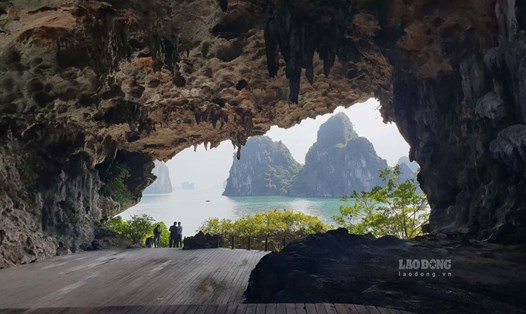Ecological conservation before economic interests
The documentary “A Crack in the Mountain” by British director Alastair Evans recounts the expedition to Son Doong Cave and the story of protecting Son Doong's ecosystem against economic interests.
Through the camera angles, Son Doong is described as having a unique natural landscape, system of lakes, trees and weather. “There was a strong wind blowing out. A strong wind often signals a large cave”, a mysterious saying that opens the journey to explore the natural wonder of the world.
According to The Guardian, Son Doong has the largest cave system on the planet in terms of volume, discovered in 1991 and explored in 2009, "the towering limestone hills, skylights and humid forests look like a scene created by computer technology, like a scene from the movie Avatar".
At its core, the film focuses on reflecting the challenges that Vietnam faces such as exploiting exploration activities, environmental conservation and sustainable development.
Director Alastair Evans said: “In today’s world, it is difficult for people to find a balance between nature conservation and economic development. I see this battle taking place fiercely in a developing country like Vietnam.”
In 2014, Quang Binh province planned to build a cable car into Son Doong, causing controversy. Many people believed that this activity would destroy the cave’s pristine ecosystem, and local people were divided by the economic benefits of exploiting tourism.
Following the group of young people who founded the Save Son Doong project to protest the construction of a cable car in the cave, director Alastair Evans shared that he himself was also wondering whether to let Vietnamese people admire the majestic and stunning beauty of the country or to limit visitors to preserve the ecosystem in Son Doong.
Changing the perspective of nature
Son Doong Cave exploration tour is currently considered an expensive tour, attracting many visitors with a ticket price of about 72 million VND/person for a 6-day, 5-night journey. Each tour has 10 explorers and about 30 service people including cave safety experts, guides, safety assistants, chefs, rangers and porters for luggage, food, and camping equipment.
Director Alastair Evans assessed that the process of exploiting and preserving natural wonders is extremely complicated, but there are 3 things Son Doong is doing well, including regulations limiting the number of tourists each year; most of the service crew members are local people; there are strict rules to protect the natural environment.
At the film’s premiere in Hanoi on September 25, many people said that most of the tourists exploring Son Doong Cave were foreigners, few Vietnamese people spent large sums of money to join the tour. Meanwhile, famous tourist destinations such as Phu Quoc, Sa Pa, and Ha Long have been degraded by the speed of development and lack of concern for the consequences of environmental pollution.
Interacting with the audience, director Alastair Evans also said that during his time working with the Quang Binh provincial government, he highly appreciated the locality’s efforts in developing sustainable tourism, in order to preserve the natural beauty, avoiding the mistakes of some other localities. The director expressed: “I hope the government will maintain this, so that Phong Nha - Ke Bang will always be a dreamland for adventure tourists”.








